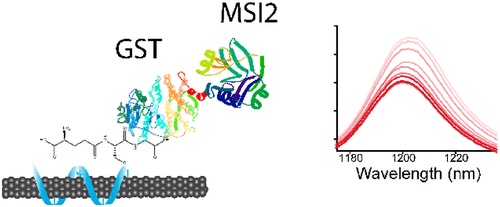当前位置:
X-MOL 学术
›
Nano Lett.
›
论文详情
Our official English website, www.x-mol.net, welcomes your
feedback! (Note: you will need to create a separate account there.)
Glutathione-S-transferase Fusion Protein Nanosensor.
Nano Letters ( IF 9.6 ) Pub Date : 2020-09-21 , DOI: 10.1021/acs.nanolett.0c02691 Ryan M Williams 1, 2 , Jackson D Harvey 1, 3 , Januka Budhathoki-Uprety 1, 4 , Daniel A Heller 1, 3
Nano Letters ( IF 9.6 ) Pub Date : 2020-09-21 , DOI: 10.1021/acs.nanolett.0c02691 Ryan M Williams 1, 2 , Jackson D Harvey 1, 3 , Januka Budhathoki-Uprety 1, 4 , Daniel A Heller 1, 3
Affiliation

|
Fusion protein tags are widely used to capture and track proteins in research and industrial bioreactor processes. Quantifying fusion-tagged proteins normally requires several purification steps coupled with classical protein assays. Here, we developed a broadly applicable nanosensor platform that quantifies glutathione-S-transferase (GST) fusion proteins in real-time. We synthesized a glutathione-DNA-carbon nanotube system to investigate glutathione-GST interactions via semiconducting single-walled carbon nanotube (SWCNT) photoluminescence. We found that SWCNT fluorescence wavelength and intensity modulation occurred specifically in response to GST and GST-fusions. The sensor response was dependent on SWCNT structure, wherein mod(n – m, 3) = 1 nanotube wavelength and intensity responses correlated with nanotube diameter distinctly from mod(n – m, 3) = 2 SWCNT responses. We also found broad functionality of this sensor to diverse GST-tagged proteins. This work comprises the first label-free optical sensor for GST and has implications for the assessment of protein expression in situ, including in imaging and industrial bioreactor settings.
中文翻译:

谷胱甘肽-S-转移酶融合蛋白纳米传感器。
融合蛋白标签广泛用于捕获和跟踪研究和工业生物反应器过程中的蛋白质。定量融合标记蛋白通常需要几个纯化步骤以及经典的蛋白质测定。在这里,我们开发了一种广泛适用的纳米传感器平台,可以实时定量谷胱甘肽-S-转移酶(GST)融合蛋白。我们合成了谷胱甘肽-DNA-碳纳米管系统,通过半导体单壁碳纳米管 (SWCNT) 光致发光研究谷胱甘肽-GST 相互作用。我们发现 SWCNT 荧光波长和强度调制专门针对 GST 和 GST 融合而发生。传感器响应取决于 SWCNT 结构,其中mod ( n – m , 3) = 1 纳米管波长和强度响应与纳米管直径相关,这与mod ( n – m , 3) = 2 SWCNT 响应不同。我们还发现该传感器对多种 GST 标记蛋白具有广泛的功能。这项工作包括第一个用于 GST 的无标记光学传感器,对原位蛋白质表达的评估具有影响,包括在成像和工业生物反应器环境中。
更新日期:2020-10-15
中文翻译:

谷胱甘肽-S-转移酶融合蛋白纳米传感器。
融合蛋白标签广泛用于捕获和跟踪研究和工业生物反应器过程中的蛋白质。定量融合标记蛋白通常需要几个纯化步骤以及经典的蛋白质测定。在这里,我们开发了一种广泛适用的纳米传感器平台,可以实时定量谷胱甘肽-S-转移酶(GST)融合蛋白。我们合成了谷胱甘肽-DNA-碳纳米管系统,通过半导体单壁碳纳米管 (SWCNT) 光致发光研究谷胱甘肽-GST 相互作用。我们发现 SWCNT 荧光波长和强度调制专门针对 GST 和 GST 融合而发生。传感器响应取决于 SWCNT 结构,其中mod ( n – m , 3) = 1 纳米管波长和强度响应与纳米管直径相关,这与mod ( n – m , 3) = 2 SWCNT 响应不同。我们还发现该传感器对多种 GST 标记蛋白具有广泛的功能。这项工作包括第一个用于 GST 的无标记光学传感器,对原位蛋白质表达的评估具有影响,包括在成像和工业生物反应器环境中。











































 京公网安备 11010802027423号
京公网安备 11010802027423号